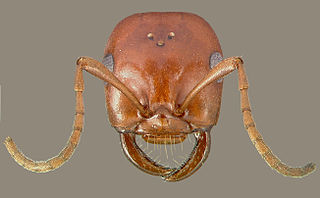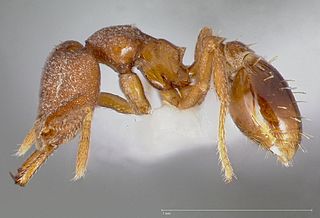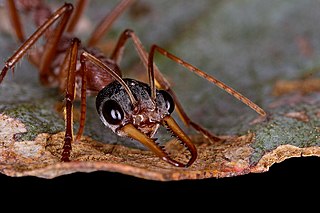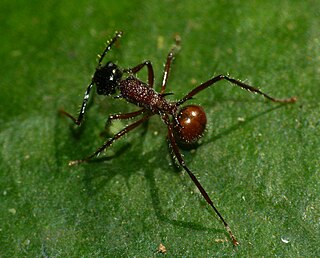
Lasius is a genus of formicine ants. The type species for this genus is the black garden ant, Lasius niger. Other major members, which live in drier heathland, are the cornfield ant, L. neoniger, and L. alienus. Other species include the temporary social parasites of the L. mixtus group and the hyper-social parasite Lasius fuliginosus. Lasius flavus is also a commonly seen species, building grassy hillocks in undisturbed pasture. In the Alps, these mounds - always aligned east to catch the first rays of the rising sun - have been traditionally used by goatherds as natural compasses. Species in the subgenus Acanthomyops, in particular L. interjectus and L. claviger, are commonly known as citronella ants due to their citronella-like smell.

Formica is a genus of ants of the family Formicidae, commonly known as wood ants, mound ants, thatching ants, and field ants. Formica is the type genus of the Formicidae, and of the subfamily Formicinae. The type species of genus Formica is the European red wood ant Formica rufa. Ants of this genus tend to be between 4 and 8 mm long.

Ponerinae is a subfamily of ants in the Poneromorph subfamilies group, with about 1,600 species in 47 extant genera, including Dinoponera gigantea - one of the world's largest species of ant. Mated workers have replaced the queen as the functional egg-layers in several species of ponerine ants. In such queenless species, the reproductive status of workers can only be determined through ovarian dissections.

Brood parasites are organisms that rely on others to raise their young. The strategy appears among birds, insects and fish. The brood parasite manipulates a host, either of the same or of another species, to raise its young as if it were its own, using brood mimicry, for example by having eggs that resemble the host's.

The Formica rufa group is a subgeneric group within the genus Formica, first proposed by William Morton Wheeler. This group contains the mound-building species of Formica commonly termed "wood ants" or "thatch-mound ants", which build prominent nests consisting of a mound of grass, litter, or conifer needles. The species Formica rufa or the red wood ant is the type species of this subgroup.

An ant colony is the basic unit around which ants organize their lifecycle. Ant colonies are eusocial, communal, and efficiently organized and are very much like those found in other social Hymenoptera, though the various groups of these developed sociality independently through convergent evolution. The typical colony consists of one or more egg-laying queens, numerous sterile females and, seasonally, many winged sexual males and females. In order to establish new colonies, ants undertake flights that occur at species-characteristic times of the day. Swarms of the winged sexuals depart the nest in search of other nests. The males die shortly thereafter, along with most of the females. A small percentage of the females survive to initiate new nests.

Carpenter ants are large ants indigenous to many forested parts of the world.

Polyergus is a small genus of ants with 14 described species. They are also referred to by the names "Slave-raiding ants" or "Amazon ants". They are characterized by their habit of raiding nests for workers.
An obligate parasite or holoparasite is a parasitic organism that cannot complete its life-cycle without exploiting a suitable host. If an obligate parasite cannot obtain a host it will fail to reproduce. This is opposed to a facultative parasite, which can act as a parasite but does not rely on its host to continue its life-cycle. Obligate parasites have evolved a variety of parasitic strategies to exploit their hosts. Holoparasites and some hemiparasites are obligate.

The banded sugar ant, also known as the sugar ant, is a species of ant native to Australia. A member of the genus Camponotus in the subfamily Formicinae, it was described by German entomologist Wilhelm Ferdinand Erichson in 1842. Its common name refers to the ant's liking for sugar and sweet food, as well as the distinctive orange-brown band that wraps around its gaster.

Strumigenys is a genus of ants in the subfamily Myrmicinae.

Formica sanguinea, or blood-red ant, is a species of facultative slave-maker ant in the genus Formica characterized by the ability to secrete formic acid. It ranges from Central and Northern Europe through Russia to Japan, China, the Korean Peninsula, Africa and also the United States. This species is coloured red and black with workers up to 7 mm long.

Myrmecia nigriceps, also known as the black-headed bull ant, is a species of ant endemic to Australia. A member of the genus Myrmecia in the subfamily Myrmeciinae, it was first described by Austrian entomologist Gustav Mayr in 1862. These ants are large, varying from 19 to 23 millimetres in length. However, colonies contain workers that are much smaller, usually half the size of normal workers. The queens are the largest while the males are the smallest, which can be easily identified due to their small mandibles.

Polyrhachis is a genus of formicine ants found in the Old World with over 600 species. The genus is yet to be comprehensively resolved and contains many varied species including nest-weavers, swimming workers, soil and tree-dwellers.
Mycocepurus castrator is a species of parasitic ant, in the genus Mycocepurus, native to Brazil. Described in 2010, the species is a workerless and obligate parasite of the related ant Mycocepurus goeldii. It is known only from Rio Claro, Brazil, and has only been found in nests of M. goeldii.

Camponotus herculeanus is a species of ant in the genus Camponotus, the carpenter ants, occurring in Northern Eurasia, from Norway to Eastern Siberia, and North America. First described as Formica herculeana by Linnaeus in 1758, the species was moved to Camponotus by Mayr in 1861.

Camponotus floridanus, or Florida carpenter ant, is a species of ant in the genus Camponotus. First described as Formica floridana by Buckley in 1866, the species was moved to Camponotus by Mayr in 1886. The ant is widespread in Florida and occurs as far north as North Carolina and as far west as Mississippi.

The black-headed sugar ant, also known as the brown sugar ant, is a species of Formicinae ant endemic to Australia. Found throughout most states, the species is a member of the genus Camponotus, a cosmopolitan genus of ants commonly known as carpenter ants. It was formally described and named by British entomologist Frederick Smith in 1858. These ants are characterised by their black head, reddish-brown mesosoma and black gaster, which can change in colour.

Novomessor albisetosus, also known as the desert harvester ant, is a species of ant found in the United States and Mexico. A member of the genus Novomessor in the subfamily Myrmicinae, it was first described by Austrian entomologist Gustav Mayr in 1886. It was originally placed in the genus Aphaenogaster, but a recent phylogenetic study concluded that it is genetically distinct and should be separated. It is a medium-sized species, measuring 6 to 8.5 millimeters and has a ferruginous body color. It can be distinguished from other Novomessor species by its shorter head and subparallel eyes.

Niphanda fusca is a parasitic butterfly primarily found in East Asian countries such as Japan and Korea. It is a "cuckoo-type" parasite of the ant Camponotus japonicus. It utilizes chemical mimicry to trick the host worker ants into adopting it while it is a third-instar caterpillar. From there, it is fed mouth-to-mouth by the worker ants as though it were one of their own young.


















